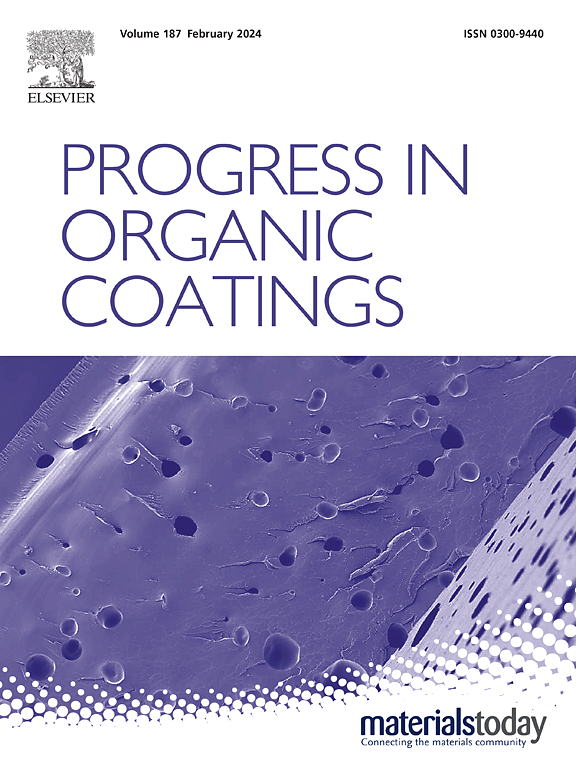Fluorine-free and breathable self-cleaning superhydrophobic CS/PDMS/PLA coatings on wearable cotton fabric with light-induced self-sterilization
IF 7.3
2区 材料科学
Q1 CHEMISTRY, APPLIED
引用次数: 0
Abstract
Developing textiles with self-sterilization and self-cleaning properties for microbial deactivation in the medical sector and high-risk areas is becoming a hot research topic. Compared with traditional methods like chemical, UV irradiation, and heat sterilization for disinfection of microbials, photothermal self-sterilization combined with superhydrophobic self-cleaning has gained considerable attention. In this study, we have developed layered coatings of candle soot/polydimethylsiloxane (CS/PDMS) and polylactic acid (PLA) on cotton fabric to achieve photothermal self-sterilization and superhydrophobic self-cleaning properties. The CS nanoparticles generate heat when exposed to light, facilitating the photothermal effect. Meanwhile, the CS nanoparticles are integrated into the polymer network, creating a hierarchical rough structure that traps air and reduces the water contact area. PDMS is a vital binder for CS nanoparticles on cotton fabric, enhancing the durability of the composite layer and reducing surface energy. The photothermal and superhydrophobic effects of the developed coating successfully demonstrated self-sterilization and self-cleaning capabilities, respectively. The as-prepared coating exhibits high water repellence with a water contact angle of 159 ± 2° and a low sliding angle of 6°. Moreover, the surface temperature of coated cotton fabric rose to 70.2 °C within 60 s under 1 sun solar illumination. Furthermore, the coating demonstrated excellent mechanical stability by maintaining its superhydrophobicity even after 55 sandpaper abrasion cycles, 12 adhesive tape peeling cycles, 140 min of ultrasound and 90 min of washing treatment. Additionally, the coated cotton exhibited excellent flexibility, breathability, air permeability, water vapor transmission, self-sterilization against gram-positive Staphylococcus aureus and gram-negative Pseudomonas aeruginosa bacteria, and self-cleaning against dust contamination. The present results have high potential for developing advanced self-cleaning cotton fabrics with contactless sterilization of microbials for commercial applications.

无氟透气超疏水CS/PDMS/PLA涂层光致自杀菌耐磨棉织物
开发具有自杀菌、自清洁性能的纺织品用于医疗领域和高风险领域的微生物灭活已成为研究热点。与化学、紫外线照射、热杀菌等传统的微生物消毒方法相比,光热自杀菌结合超疏水自清洁已受到广泛关注。在这项研究中,我们在棉织物上开发了蜡烛烟灰/聚二甲基硅氧烷(CS/PDMS)和聚乳酸(PLA)的分层涂层,以实现光热自杀菌和超疏水自清洁性能。CS纳米颗粒在暴露于光下时会产生热量,促进光热效应。同时,CS纳米颗粒被整合到聚合物网络中,形成一个分层的粗糙结构,可以捕获空气并减少水的接触面积。PDMS是棉织物上CS纳米颗粒的重要粘合剂,可以增强复合层的耐久性并降低表面能。所开发的涂层的光热和超疏水效果分别成功地证明了自杀菌和自清洁能力。所制备的涂层具有较高的拒水性,水接触角为159±2°,滑动角为6°。在1个太阳照射下,涂层棉织物的表面温度在60 s内上升到70.2°C。此外,该涂层在经过55次砂纸磨损、12次胶带剥离、140分钟超声和90分钟洗涤处理后仍保持超疏水性,表现出优异的机械稳定性。此外,包被棉还具有良好的柔韧性、透气性、透气性、水蒸气透气性、对革兰氏阳性金黄色葡萄球菌和革兰氏阴性铜绿假单胞菌的自杀菌能力和对粉尘污染的自清洁能力。目前的研究结果在开发具有非接触灭菌微生物的先进自洁棉织物方面具有很高的潜力。
本文章由计算机程序翻译,如有差异,请以英文原文为准。
求助全文
约1分钟内获得全文
求助全文
来源期刊

Progress in Organic Coatings
工程技术-材料科学:膜
CiteScore
11.40
自引率
15.20%
发文量
577
审稿时长
48 days
期刊介绍:
The aim of this international journal is to analyse and publicise the progress and current state of knowledge in the field of organic coatings and related materials. The Editors and the Editorial Board members will solicit both review and research papers from academic and industrial scientists who are actively engaged in research and development or, in the case of review papers, have extensive experience in the subject to be reviewed. Unsolicited manuscripts will be accepted if they meet the journal''s requirements. The journal publishes papers dealing with such subjects as:
• Chemical, physical and technological properties of organic coatings and related materials
• Problems and methods of preparation, manufacture and application of these materials
• Performance, testing and analysis.
 求助内容:
求助内容: 应助结果提醒方式:
应助结果提醒方式:


